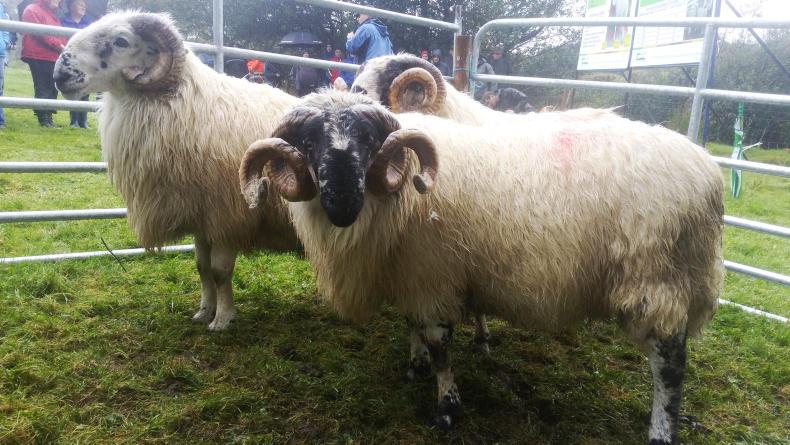Over 60 farmers braved the rain and difficult weather which has become too familiar a sight this year to attend last Wednesday’s hill sheep breeding farm walk hosted by Denis O’Riordan, Borlin, Bantry, Co Cork, in close proximity to Cnoc Bui on the Cork and Kerry border.
Denis’s farmyard is located at an altitude of 600ft above sea level, with commonage land, where sheep have access to grazing rising to over 1,700ft above sea level.
 The farm consists of 271ha hill grazing of varying quality, 60ha of which is fenced. Along with this, there is 8ha of enclosed lands containing better-quality grazing and an 8ha outfarm, which is also used for grazing sheep and sucklers.
The farm consists of 271ha hill grazing of varying quality, 60ha of which is fenced. Along with this, there is 8ha of enclosed lands containing better-quality grazing and an 8ha outfarm, which is also used for grazing sheep and sucklers.
Denis joined the Teagasc BETTER farm sheep programme in 2014 and has been working with local B&T adviser Michael Connolly, head of sheep programme Michael Gottstein, previous programme adviser Ciaran Lynch and more recently newly appointed programme adviser Frank Campion.

Breeding performance in the 285-ewe Scottish Blackface hill flock is starting from a good base, with 95% of ewes joined last autumn lambing this spring and rearing 1.09 lambs per ewe joined.
The focus in future years is to experiment with different ewe breeds in a bid to lift animal performance. Some Swaledale and Lanark breeding is being used this year alongside traditional Blackface rams, with their performance compared, while greater use is also being made of performance records to select the best-performing ewes to enter the optimum breeding strategy.
For example, the bottom 25% of Scotch ewes are mated with a Suffolk ram, with crossbreeding having potential to increase performance and value of these progeny.
Targeted use of grazing
Greater focus is also being placed on using enclosed lands to greater effect at lambing, breeding and in bringing lambs to heavier weights (30kg+ in August) to increase sale value of stores.
Finishing of lighter store lambs will also be considered if it adds value and generates a margin over finishing costs. This will be achieved through improved grassland management and soil fertility deficits being addressed across the farm.
Ewe condition and liveweight
Two outdoor stands focused on pre-breeding examinations of ewes and rams. Sheep specialist Frank Hynes told farmers at the event that while output varies across hill sheep flocks, depending on the quality of lands being farmed, output can, in most cases, be increased by having ewes in the correct body condition score (BCS) at mating.

This will affect pregnancy rate, as shown in Figure 1, and litter size, as shown in Figure 2, while also tightening the lambing spread.

Frank said farmers should aim for a target BCS at mating of 3. He said that BCS can only be accurately assessed by carrying out an examination where ewes are physically handled.
This should ideally be carried out 10 weeks in advance of the breeding season and at the latest six weeks before breeding, with a shorter time frame making it difficult to gain the required liveweight and condition.
He said that, in most cases, there should be scope to improve ewe condition through preferential grazing, but, where this is not possible, targeted concentrate feeding can play a role.
As well as a physical examination, Frank recommended keeping good records of ewes to see which are doing a good job and which ewes are best used to breed flock replacements.
Ram NCT
In preparing rams for breeding, Michael Gottstein advised farmers to “buy a ram from someone you trust or buy one six weeks before you need him”.
This is to allow a quarantine procedure to be put in place and any required changes in body condition to be carried out well in advance of the breeding season. Teeth and feet were other areas highlighted as important when carrying out a ram NCT.
When questioned on how many ewes a ram should run with, Gottstein responded saying one ram to 45 ewes is a safe bet, but recommended having at least three rams if you wanted to be bullet proof.

“If you only have one and he is infertile, you are in trouble. If you have two and one is infertile, he may act as a blocker ram. If you have three, a blocker ram can’t block two rams from mating a ewe,” he said.
He added that anything that negatively affects a ram, such as lameness or illness or a chill that alters body temperature, can have a dramatic knock-on effect on next year’s lamb flock, advising farmers to be vigilant for signs of sickness and to take the appropriate actions to limit the impact of ram subfertility or infertility (raddling, running rams in groups or switching between groups).
For rams falling below target condition at present, he recommended feeding a balanced ration rather than straight oats. As with ewes, he also recommended feeding in advance of the breeding season, saying two weeks beforehand is too late.






 This is a subscriber-only article
This is a subscriber-only article










SHARING OPTIONS: